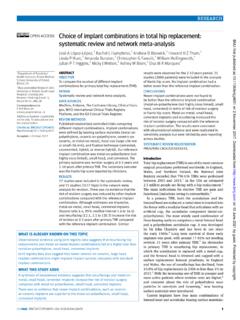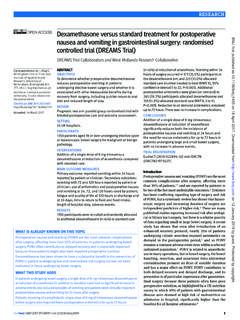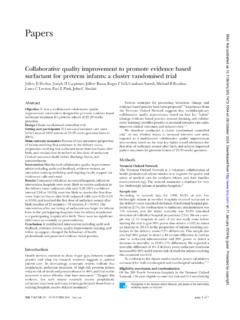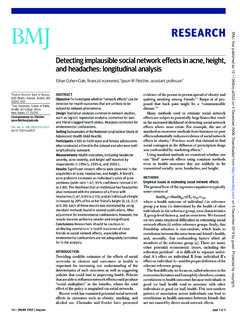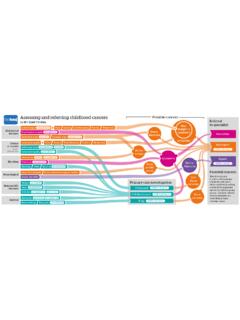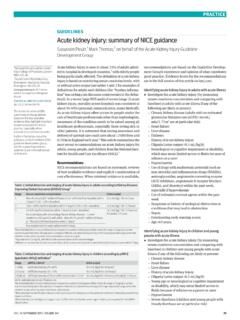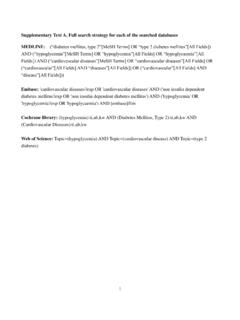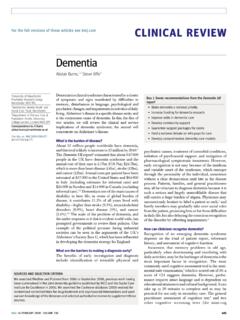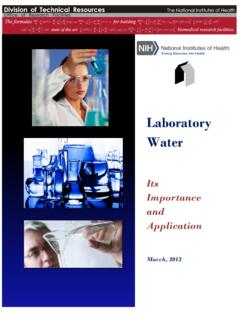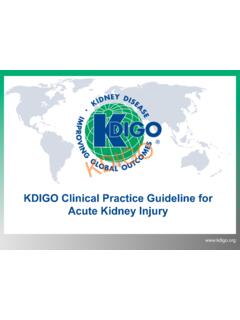Transcription of Management of acute upper gastrointestinal bleeding - BMJ
1 For personal use only 1 of 13summarizing evidence for risk assessment, resuscitation, blood transfusion, medical and endoscopic therapy, and early post-endoscopic Management . We will not review interventions for long term secondary prevention of bleeding , such as testing for and treating Helicobacter pylori infection, use of non-steroidal anti-inflammatory drugs (NSAIDs), or maintenance antisecretory gastrointestinal bleeding is managed by many cli-nicians across many specialties, including emergency room physicians, hospitalists, internists, gastroenterologists, surgeons, interventional radiologists, and variety of topics including risk assessment, the threshold for blood transfusion, the timing of endoscopy, and medical and endoscopic therapies have continued to evolve in recent years.
2 In addition, it has become increas-ingly important and complex to determine the appropriate Management of patients who need antithrombotic agents, with gastroenterological, cardiovascular, and hematologi-cal aspects needing to be article provides a comprehensive and evidence based summary of the assessment and Management of patients with acute upper gastrointestinal bleeding , which is relevant to clinician specialists, academics, and clinical researchers. A summary of Management is provided in the OF THE ART REVIEW IntroductionUpper gastrointestinal bleeding is a common medical emergency worldwide and refers to bleeding from the esophagus, stomach, or duodenum.
3 Patients present with hematemesis (bloody or coffee ground emesis) or melena, although hematochezia can occur in the context of a major bleed and is typically associated with hemodynamic insta-bility. Patients with melena present with lower hemo-globin values than patients with hematemesis, probably because presentation is more likely to be There-fore, patients with melena more often require transfusion, although mortality is lower in patients with melena than in those with hematemesis in some Numerous improvements in the Management of upper gastrointesti-nal bleeding have been incorporated into clinical practice in recent years.
4 However, many patients now have risk factors for a poorer outcome, including increasing age and major medical the cause of a bleeding episode is uncertain until endoscopy is undertaken, guidelines often separate upper gastrointestinal bleeding into variceal and non-variceal bleeding because Management and outcomes This article covers the acute Management of patients with overt upper gastrointestinal bleeding , ABSTRACTU pper gastrointestinal bleeding (UGIB) is a common medical emergency, with a reported mortality of 2-10%. Patients identified as being at very low risk of either needing an intervention or death can be managed as outpatients.
5 For all other patients, intravenous fluids as needed for resuscitation and red cell transfusion at a hemoglobin threshold of 70-80 g/L are recommended. After resuscitation is initiated, proton pump inhibitors (PPIs) and the prokinetic agent erythromycin may be administered, with antibiotics and vasoactive drugs recommended in patients who have cirrhosis. Endoscopy should be undertaken within 24 hours, with earlier endoscopy considered after resuscitation in patients at high risk, such as those with hemodynamic instability. Endoscopic treatment is used for variceal bleeding (for example, ligation for esophageal varices and tissue glue for gastric varices) and for high risk non-variceal bleeding (for example, injection, thermal probes, or clips for lesions with active bleeding or non- bleeding visible vessel).
6 Patients who require endoscopic therapy for ulcer bleeding should receive high dose proton pump inhibitors after endoscopy, whereas those who have variceal bleeding should continue taking antibiotics and vasoactive drugs. Recurrent ulcer bleeding is treated with repeat endoscopic therapy, with subsequent bleeding managed by interventional radiology or surgery. Recurrent variceal bleeding is generally treated with transjugular intrahepatic portosystemic shunt. In patients who require antithrombotic agents, outcomes appear to be better when these drugs are reintroduced earlyManagement of acute upper gastrointestinal bleedingAdrian J Stanley,1 Loren Laine21 Department of Gastroenterology, Glasgow Royal Infirmary, Glasgow G4 OSF, UK2 Section of Digestive Diseases, Yale School of Medicine, New Haven, and VA Connecticut Healthcare System, West Haven, Connecticut, CT 06520, USAC orrespondence to: A J Stanley and this as: BMJ 2019.
7 364:l536doi: explanation: State of the Art Reviews are commissioned on the basis of their relevance to academics and specialists in the US and internationally. For this reason they are written predominantly by US authors on 5 April 2022 by guest. Protected by : first published as on 25 March 2019. Downloaded from STATE OF THE ART REVIEWFor personal use only 2 of 13 Overall quality of evidenceNumerous randomized controlled trials (RCTs) and meta-analyses have assessed the use of medical and endoscopic therapy, and the optimal blood transfusion strategy in patients with acute upper gastrointestinal bleeding , thereby providing high quality data to guide Management .
8 Although the evidence regarding resuscita-tion, risk assessment, timing of endoscopy, and reintro-duction of antithrombotic drugs is of lower quality, large recent studies in these areas have helped inform patient incidence of upper gastrointestinal bleeding in the United Kingdom in the 1990s was 103-172/100 000 adults per 11 Recent reports from the United States using nationwide administrative databases indicate that the incidence of hospital admission for the condition was 61-78 per 100 000 persons in Peptic ulcers are the most common cause of hospital admission for upper gastrointestinal bleeding .
9 Accounting for just over half of all 14 The incidence of hospital admis-sion for the condition has decreased 21-23% during the past 10 14 This decrease is largely accounted for by decreases in peptic ulcer bleeding (and bleeding ascribed to gastritis ) probably because of the decreas-ing prevalence of H pylori and increasing use of antisecre-tory drugs. Case fatality rates from these database studies were low, in the range of By contrast, large observational cohort studies from Europe suggest higher fatality rates of around 10%.15 16 The reason for these differences is unknown but might be partly related to reliance on coding in database studies and differences in practice, such as low risk patients being more often managed in outpatient settings in and selection criteriaWe searched PubMed, Medline, and Cochrane databases from 2010 to August 2018 using the search terms gastro-intestinal hemorrhage, peptic ulcer bleeding , and variceal bleeding .
10 References were also identified from the inter-national, UK, European, American, and Asia-Pacific guidelines on upper gastrointestinal bleeding published during this period in addition to relevant review articles. We selected systematic reviews, meta-analyses, RCTs, and observational studies (excluding case reports and small (<15 cases) case series). We also excluded articles that were not peer reviewed and those not published in Eng-lish. Studies were prioritized by design, as noted above, and by patient numbers, quality, and publication resuscitationAs with any new patient with a medical emergency, the initial clinical evaluation of patients presenting with upper gastrointestinal bleeding involves assessment of the patient s airway, breathing, and circulation.


